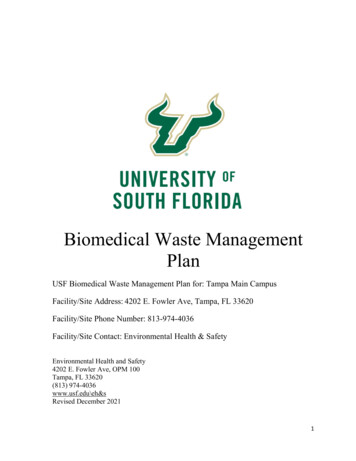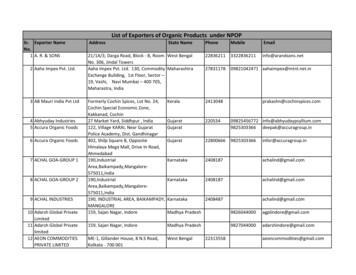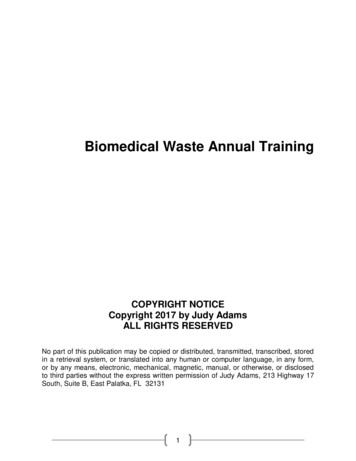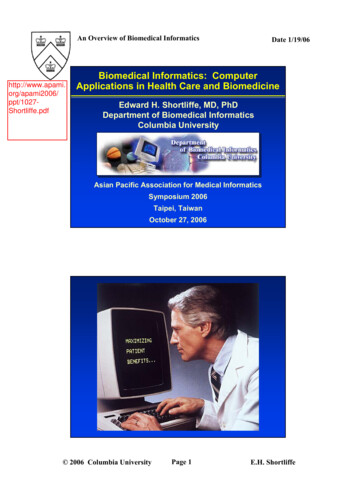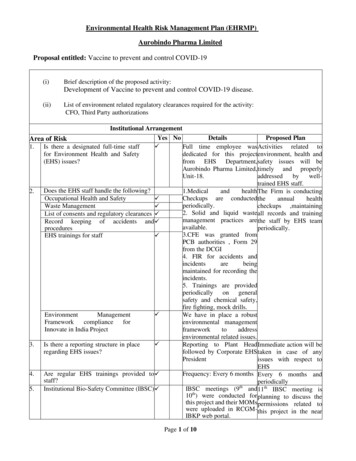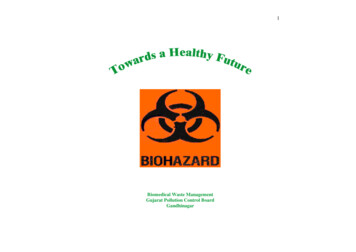
Transcription
1Biomedical Waste ManagementGujarat Pollution Control BoardGandhinagar
2INTERPRETATION OFIOMEDICAL WASTE (MANAGEMENT AND HANDLING) RULES1.0 INTRODUCTIONThe management of health care waste is a subject of considerable concern to publichealth and infection-control specialists, as well as the general public. It is a wellknown fact that in several types of health care activities, various types of hazardousand contagious materials are generated. Even though the consequences of discardingsuch waste carelessly are well known, it is only recently that adequate initiatives tomanage this waste in a scientific manner are being taken in India.Unscientific disposal of health care waste may lead to the transmission ofcommunicable diseases such as gastro-enteric infections, respiratory infections,spreading through air water and direct human contact with the blood and infectiousbody fluids. These could be responsible for transmission of Hepatitis B, C, E andAIDS within the community. Health care professionals and the general public are atrisk due to this. Diseases are spread by improper treatment and disposal of waste.Rag pickers expose themselves to diseases like Hepatitis B, Tetanus, Staphylococci,etc. while handling items like needles, surgical gloves, blood bags etc.2.0 Biomedical Waste (Management and Handling) Rules:The Bio-Medical Waste (Management and Handling) Rules; 1998 are conferred bysection 6,8, 25 of the Environment (Protection) Act, 1986 (29 of 1986).Environment (Protection) Act, 1986This Act is an umbrella legislation providing a single focus in the country for theprotection of Environment and seeks to plug the loopholes of earlier legislationrelating to environment. Several sets of rules relating to various aspects ofmanagement of hazardous chemicals, waste, microorganisms, biomedical waste etc.,
31. Whoever fails to comply with or contravenes any of the provisions of this Act, or therules made or orders or directions issued there under, shall in respect of each such failureor contravention, be punishable with imprisonment for a term which may extend to onefive years or with fine which may extend to one lakh rupees, or with both, and in case thefailure or contravention continues with additional fine which may extend to fivethousand rupees for every day during which such failure or contravention continues afterthe conviction for the first such failure or contravention.2.If the failure or contravention referred to in sub-section (1) continues beyond aperiod of one year after the date of conviction, the offender shall be punishable withimprisonment for a term which may extend to seven years.3.0 Application: These rules apply to all persons who generate, collect, receive,store, transport, treat, dispose or handle bio-medical waste in any form.Biomedical waste means any waste, which is generated during the diagnosis,treatment or immunization of human beings or animals or in research activitiespertaining thereto or in the production or testing of biologicals (means anypreparation made from organisms or micro-organisms or product of metabolism andbiochemical reactions intended for use in the diagnosis, immunization or thetreatment of human beings or animals or in research activities pertainingthereto;)including categories mentioned in schedule-I.These Rules will apply to all institutions generating biomedical waste which includeshospitals, nursing homes, clinics, dispensaries, veterinary hospital, animal house,research and pathological lab, and Blood Bank etc., generating biomedical waste.The Biomedical Waste (Management and Handling) Rules 1998, explicitly state thatwaste handling and treatment facilities shall have to be established within stipulateddeadlines or earlier, for all waste generating establishments. It is to be also noted that the hospitals/clinics/ nursing homes/ dispensaries etc.,which treat below 1000 patients/month though do not have to apply for authorisationstated above but have to comply with the BMW rules.2.0 DUTY OF OCCUPIER GENERATING BIO-MEDICAL WASTE:CartoonIt shall be the duty of every occupier of an institution generating bio-medical wastewhich includes a hospital, nursing home, clinic, dispensary, veterinary institution,
42)3)4)5)6)7)The occupier where required should set up the bio-medical treatment facility((Biomedical waste treatment facility means any waste facility wherein treatment,disposal of Bio-medical waste or processes incidental to such treatment or disposalis carried out and includes common treatment facility) and ensure requisite treatmentof waste at a common treatment facility or any other waste treatment facility.It is the duty of occupier to ensure proper segregation of waste into container/bagsat the point of generation. He should also ensure proper labeling of these bagsaccording to schedule III and IV.The occupier should ensure maintenance of records about the generation,collection, reception, storage, transportation, treatment, disposal and or any form ofhandling biomedical waste.Make an application to the concerned authorities (Pollution Control Committees incase of Union Territories) for grant of authorisation shall be accompanied by as a feeas may be prescribed by the concerned State Government.Submit a report to the prescribed authority by 31st January every year. The reportshould include information about the categories and quantities of biomedical wastehandled during the preceeding year (Form II).Report any accident to the prescribed authority Form-III.3.0 TREATMENT OF WASTE:(1) (1) Bio-medical waste shall be treated and disposed of in accordance with ScheduleI, and in compliance with the standards prescribed in Schedule V.(2) Every occupier, where required, shall set up in accordance with the timeschedule in Schedule VI, requisite bio-medical waste treatment facilities likeincinerator, autoclave, microwave system for the treatment of waste, or, ensurerequisite treatment of waste at a common waste treatment facility or any other wastetreatment facility.1) Treatment may be defined as the process that changes the character of hazardouswaste to render them less hazardous or non-hazardous. Treatment renders wasteunrecognisable and may or may not reduce volume.2) Treatment of BMW should depend upon nature of the waste, volume of waste andtechnology (i.e. technologically and economically viable and environmentally safe) andmust meet regulatory standards & public acceptance.3) Sometimes pre-treatment of waste may be required before storage/ transportation or
5WasteCategoryNo.1234CATEGORIES OF BIO-MEDICAL WATE AND THE VAROIUS DISPOSALTECHNOLOGIES ADOPTEDWaste Category (Type)Treatment &Type of container plastic ColourDisposalbagcodingHuman Anatomical Waste: Incineration/(Human tissues, organs, body deep burialparts)Plastic bagyellowAnimal Waste:(Animaltissues, organs, body parts,carcasses, bleeding parts, fluids,blood, experimental spitals colleges, dischargefrom hospitals, animal houses)Microbiology & Biotechnologywaste: (Waste from laboratorycultures, stocks or specimens ofmicro-organisms,liveorattenuated vaccines, human andanimal cell culture used inresearch and infectious agentsfrom research and icals,toxins, dishes and devices usedfor transfer of cultures).Incineration/deep burialPlastic bagyellowLocalautoclaving/incineration,micro wavingPlasticbag/disinfected ,blades,glass(broken and unbroken) etc.that may cause punctures andcuts. This includes both usedDisinfection by Plasticbag/punctureproochemicalf whitetranslucent
67Solid Waste: (Waste generatedfrom disposable items other thanwaste sharps such as catheters,intravenous sets, etc).8LiquidWaste:(Wastegenerated from laboratory ivities).Incineration Ash: (Ash fromincineration of any bio- medicalwaste).910Chemical Waste:( chemicals used in productionof biologicals, chemicals usedin disinfections, as toclaving/microwavingand mutilation/shreddingDisinfection municipallandfill.Chemicaltreatment/discharges into drainsfor liquids andsecured landfillsfor solids.Plastic bag/ puncture Red/proof containerblue/whitetranslucent.Plastic bagBlackPlastic bagBlack@@ Chemicals treatment using at least 1% hypochlorite solution or any otherequivalent chemical reagent. It must be ensured that chemical treatment ensuresdisinfection.Chemical disinfectionI.I.Chemical disinfection is used routinely in health care to kill microorganismson medical equipment and on the floors and walls, is now being extended to thetreatment of health-care waste. Chemicals are added to waste to kill or inactivate thepathogens it contains; this treatment usually results in disinfection rather thansterilization. Chemical disinfection is most suitable for treating liquid waste such as
7V.VI.VII.VIII.The aim of disinfection is to eliminate microorganisms or at at least reduce theirnumbers to a “satisfactory” level. Some disinfectants are effective in killing orinactivating specific types of microorganisms and others are effective against alltypes. It is therefore essential to know the identity of the target microorganisms to bedestroyed. However, selection of disinfectants depends not only on theireffectiveness, but also on their corrosiveness and other hazards related to theirhandling.The types of chemicals used for disinfection of health-care waste are mostlyaldehydes, chlorine compounds, ammonium salts, and phenolic compounds; thecharacteristics of those most commonly used for waste applications.Powerful disinfectants are often hazardous and toxic; many are harmful to skinand mucous membranes. Users should therefore wear protective clothes, includinggloves and protective clothes, including gloves and protective glasses or goggles.Disinfectants are also aggressive to certain building materials and should be handledand stored accordingly.Small amounts of disinfectants can be discharged into sewers withoutpretreatment, provided that there is an adequate sewage-treatment process; largeamounts of disinfectants should never be discharged into sewers. No disinfectantsshould be discharged into natural water bodies.## Mutilation/shredding must be such so as to prevent unauthorized reuse.Shredding of solid waste health-care waste before disinfection is essential for thefollowing reasons: To increase the extent of contact between waste and disinfection by increasing thesurface area and eliminating and any enclosed spaces; To render any body parts unrecognizable to avoid any adverse visual impact ondisposal; To reduce the volume of waste.It is to be taken care of that mutilation/shredding must be done in such a manner asthe original shape is not maintained and the waste cannot be reused again.@ There will be no chemical pretreatment before incineration. Chlorinated plasticsshall not be incinerated.* Deep burial shall be an option available only in towns with population less than
85. The deep burial site should be relatively impermeable and no shallow well shouldbe close to the site.6. The pits should be distant from habitation, and sited so as to ensure that nocontamination occurs of any surface water or ground water. The area should not beprone to flooding or erosion.7. The location of the deep burial site will be authorised by the prescribed authority.8. The institution shall maintain a record of all pits for deep burial.Notes:1. Colour coding of waste categories with multiple treatment options as defined inSchedule I, shall be selected depending on treatment option chosen, which shall be asspecified in Schedule I.2. Waste collection bags for waste types needing incineration shall not be made ofchlorinated plastics.3. Categories 8 and 10 (liquid) do not require containers/bags.4. Category 3 if disinfected locally need not be put in containers/bags.Segregation, Packaging, Transportation and Storage(1) Bio-medical waste shall not be mixed with other wastes.(2) Bio-medical waste shall be segregated into containers/bags at the point ofgeneration in accordance with Schedule II prior to its storage, transportation,treatment and disposal. The containers shall be labelled according to Schedule III.(3) If a container is transported from the premises where bio-medical waste isgenerated to any waste treatment facility outside the premises, the container shall,apart from the label prescribed in Schedule III, also carry information prescribed in
9The key to minimization and effective management of health-care waste issegregation (separation) and identification of the waste. Appropriate handling,treatment and disposal of waste by type reduces costs and does much to protectpublic health. Segregation is the key to any waste management scheme. Bysegregation, different categories and types of BMW are sorted and placed in differentcontainers or bags as specified in schedule II of BMW rules. Segregation at source isnecessary, as the different types of waste need treatment and disposal. It is a safemethod by which the generator and the handler to help in - (i) reduce the totaltreatment cost, (ii) ensuring that general waste does not become infectious and (iii)reduce the chances of infection in health care worker.Segregation should always be the responsibility of the waste producer, should takeplace as close as possible to where the waste is generated. The most appropriate wayof identifying the categories of health- care waste is by sorting the waste into colourcoded plastic bags or containers. The rules do not mention a particular colour forgeneral waste. Therefore, the hospital authorities may use any other appropriatecolour for the general waste.The collection of bio-medical waste should be done in accordance with the directionscontained in the notification of BMW Rules as per the provisions of the BMW Rules'98.1) Waste should be segregated and clearly labelled at source. It is mandatory that thebiohazard symbol must be clearly seen on the bins collecting biomedical waste. This isthe most important step in handling waste and mainly from the patient care areas.2) A system of colour code for containers and types of waste should be followed.Appropriate containers or bag holders should be placed in all locations where particularcategories of waste may be generated. Instructions on waste separation and identificationshould be posted at each waste collection point to remind staff of the procedures.Containers should be removed when they are three-quarters full. Ideally the plastic bagsshould be made of combustible, non-halogenated plastics.3) Staff should never attempt to correct errors of segregation by removing items from abag or container after disposal or by placing one bag inside another bag of a differentcolour.4) If general and hazardous waste are accidentally mixed, the mixture should be treatedas hazardous health care waste.5) Waste should be collected daily (or as frequently as required) and transported todesignated central storage site. Nursing and other clinical staff should ensure that wastebags are tightly closed or sealed when they are about three-quarters full. Bags should notbe closed by stapling. The bags or containers should be replaced immediately with new
1011)Waste must be transported away from the areas of generation at regularintervals or every morning. Breakdowns in transport will play wide spread havoc on theentire system and therefore back-up staff and equipment must be planned for, and madeavailable.12)Transport of waste from areas of generation must be done only bydesignated staffs, aware of the hazards of the material they handle and of protectivemeasures to be taken. They should be provided with adequate personal protectiveequipment and should be instructed to report any injury to the medical authorities.13)Untreated biomedical waste shall be transported only in specially designedvehicles.14)No untreated bio-medical waste shall be stored beyond a period of 48 hours.15)The transport vehicle (cart / barrow) must be designated and must not beused for any other purpose.16)If for any reasons it becomes necessary to store the waste beyond a periodof 48 hours, permission from the prescribed authority (Pollution Control Board andPollution Control Committee, established by the Government of every State and UnionTerritory) must be taken, and it must be ensured that it does not adversely affect humanhealth and the environment.17)Before final disposal, infectious waste must be subjected to treatment witheither heat or chemicals. Non-infectious waste need not be treated.18)Regular medical check-up for the staff is mandatory. Immunisation againstHepatitis B and other blood borne diseases is mandatory.In contrast to the available data that says that biomedical waste form only 15-20% ofthe total waste generated it has been ascertained through estimation at varied sourcesthat in large hospitals (above 500 beds), the quantity of biomedical waste is about33% of the total waste generated. However in nursing homes, dispensaries,diagnostic labs, blood banks, clinics and even veterinary and research institutions, theproportion of biomedical waste to the total waste is much higher ranging from almost50% in clinics, labs, blood banks, to 95% in veterinary and research institutions.[Based on the CEE, Delhi, cross-sectional study of knowledge and compliance toBiomedical Waste (Management and Handling) IRTREATMENT
11SCHEDULE I(see Rule 5)CATEGORIES OF BIO-MEDICAL WASTEWasteWaste Category (Type)TreatmentCategory&DisposalNo.Human Anatomical Waste: (Human tissues, organs, body Incineration/ deep1parts)burial2Animal Waste:(Animal tissues, organs, body parts, Incineration/ deepcarcasses, bleeding parts, fluids, blood, experimental animals burialused in research, waste generated by veterinary hospitalscolleges, discharge from hospitals, animal houses).3Microbiology & Biotechnology waste: (Waste fromlaboratory cultures, stocks or specimens of micro-organisms,live or attenuated vaccines, human and animal cell cultureused in research and infectious agents from research andindustrial laboratories, waste from production of biologicals,toxins, dishes and devices used for transfer of cultures).4Waste sharps: (Needles, syringes, scalpels, blades, Disinfectionbyglass(broken and unbroken) etc. that may cause punctures chemicaland cuts. This includes both used and unused sharps).treatment/autoclaving, microwavingandmutilation/shredding.Discarded Medicines & cytotoxic drugs: (Wastes comprising Incineration/of outdated, contaminated drugs and discarded medicines)destructionanddisposalinsecured landfillsSoiled waste: (Items contaminated with blood, body fluids Incineration/including cotton, dressing, soiled plaster casts, linens, autoclaving/ andbedding, other material contaminated with n,microwavingSolid Waste: (Waste generated from disposable items other Disinfectionthan waste sharps such as catheters, intravenous sets, etc).chemical.treatment,-
12## Multilation/shredding must be such so as to prevent unauthorised reuse.@ There will be no chemical pretreatment before incineration. Chlorinatedplastics shall not be incinerated.* Deep burial shall be an option available only in towns with population lessthan five lakhs and in rural areas.SCHEDULE –II(see Rule 6)COLOUR CODING AND TYPE OF CONTAINER FOR DISPOSAL OFBIOMEDICAL WASTEColourcodingTypecontainerYellowPlastic ncture proofcontainer3,6,7Plastic No.1,2,3,64,7Treatment options asper Schedule emical TreatmentAutoclaving/Microwaving/Chemical Treatmentanddestruction/shreddingDisposal in securedlandfill.Notes:1. Colour coding of waste categories with multiple treatment options as defined inSchedule I, shall be selected depending on treatment option chosen, which shall be asspecified in Schedule I.2. Waste collection bags for waste types needing incineration shall not be made ofchlorinated plastics.3. Categories 8 and 10 (liquid) do not require containers/bags.4. Category 3 if disinfected locally need not be put in containers/bags.PRESCRIBED AUTHORITY:
13(5) An authorisation shall be granted for a period of three years, including an initialtrial period of one year from the date of issue. Thereafter, an application shall bemade by the occupier/operator for renewal. All such subsequent authorisation shallbe for a period of three years. A provisional authorisation will be granted for thetrial period, to enable the occupier/operator to demonstrate the capacity of thefacility.(6) The prescribed authority may after giving reasonable opportunity of being heardto the applicant and for reasons thereof to be recorded in writing, refuse to grant orrenew authorisation.(7) Every application for authorisation shall be disposed of by the prescribedauthority within ninety days from the date of receipt of the application.(8) The prescribed authority may cancel or suspend an authorisation, if for reasons,to be recorded in writing, the occupier/operator has failed to comply with anyprovision of the Act or these rules :Provided that no authorisation shall be cancelled or suspended without giving areasonable opportunity to the occupier/operator of being heard.As per the BWM (Second Amendment) Rules, 2000, the prescribed authority ofenforcing the provisions in the rules, shall be the State Pollution Control Boards instates and State Pollution Control Committees in respect to the Union territories.Accordingly all the prescribed authorities appointed earlier by respective State Govt.and Union territories shall be transferred to the concerned State Pollution ControlBoard/ Pollution Control Committees. However, these prescribed authorities if notState Pollution Control boards/ Committees shall automatically be transferred toconcerning State Pollution Control Board in respect of States and the PollutionControl Committees in case of Union Territories. The authorisation fee structure isalso different for different states.As per the provisions of this section the responsibility of the prescribed authority(Pollution Control Board/ Pollution Control Committees) & the occupier has beendefined. The powers & responsibilities of the prescribed authority given under thissection are:- - Grant for authorisation to the institutions covered under this rule.- - Implementing various provisions of this rule for proper management & handling of
14- -- - - - -To give all the relevant information (no. of beds, storage, treatment, disposalfacilities etc. )along with necessary fee, as prescribed by the Pollution control Board/Pollution Control Committees, for grant of authorisation.To renew the authorisation within the specified period.Refusal or suspension of authorisation only when recorded in writing giving reason.Automatic grant of authorisation if the application not disposed by the prescribedauthority within ninety days of receipt of the application is complete in all respects.Follow5.0 AUTHORISATION:(1) Every occupier of an institution generating, collecting, receiving, storing,transporting, treating, disposing and/or handling bio-medical waste in any other manner,except such occupier of clinics, dispensaries, pathological laboratories, blood banksproviding treatment/service to less than 1000 (one thousand) patients per month, shallmake an application in Form 1 to the prescribed authority for grant of authorisation.(2) Every operator of a bio-medical waste facility shall make an application in Form 1 tothe prescribed authority for grant of authorisation.(3) Every application in Form 1 for grant of authorisation shall be accompanied by a feeas may be prescribed by the Government of the State or Union Territory.(4) The authorisation to operate a facility shall be issued in Form IV, subject toconditions laid therein and such other condition as the prescribed authority, mayconsider it necessary.As per the provisions of this section every occupier generating, receiving, storing,transporting, treating, disposing and/or handling biomedical waste in any mannerhave to obtain the authorisation from the prescribed authority. However, clinics,dispensaries, pathological laboratories, blood banks providing treatment services toless than 1000 patients per month are not required to obtain authorisation, but, theyhave to comply with the provisions of this rule for proper management & handling ofbio-medical waste generated in their premises.The application of authorisation should be as per prescribed proforma in Form I ofBMW Rules ’98. The authorisation will be granted in prescribed proforma along withconditions laid down by the prescribed authority as fits the proper management ofBMW.
15(B)(C)Every occupier of an institution generating collecting, receiving, storing, Transporting, 1000disposing and per handling biomedical waste in any other manner, including clinic,dispensaries, pathological laboratories, blood banks, veterinary institution, animal house, bywhatever name called, but not included in A above.Every Institution and operator connected with Management and handling of Bio-Medical waste.i) The Operators having an incinerator with capacity upto 50 kgs,per hour10,000ii) Waste operator having an incinerator with capacity of more than 50 kegs per hour20,000iii) Operator having facilities other than incinerator10006.0 ADVISORY COMMITTEEThe Government of every State/Union Territory shall constitute an advisorycommittee. The committee will include experts in the field of medical and health,animal husbandry and veterinary sciences, environmental management, municipaladministration, and any other related department or organistaionincludingnon-governmental organisations. As and when required, the committee shall advisethe Government of the State/ Union Territory and the prescribed authority aoutmatters related to the implementation of these rules.As per the provisions of this rule every State Govt./ Union territory shall constitutean advisory committee which will include experts in the related field. This committeewhich will include experts in the related field. This committee will advise the Govt.and the prescribed authority on matters related to the implementation of these rules aswhen required.7.0 ANNUAL REPORT:Every occupier/operator shall submit an annual report to the prescribed authority inForm 11 by 31 January every year, to include information about the categories andquantities of bio-medical wastes handled during the preceding year. The prescribedauthority shall send this information in a compiled form to the Central PollutionControl Board by 31 March every year.As per the provisions under this section every occupier/ operatorhandling or
16This section provides for maintaining proper records of bio-medical waste generated,collected, recepted, stored, transported, treated, disposed and /or in any form handledby the occupier. These records may be inspected and verified by the representativesof the prescribed authority at any time.8.0 ACCIDENT REPORTING:When any accident occurs at any institution or facility or any other site where biomedical waste is handled or during transportation of such waste, the authorisedperson shall report the accident in Form Ill to the prescribed authority forthwith.This section provides for a procedure for reporting accidents or incidents and recordsto be kept. Such report should include the nature of accidents when and where theyoccurred and which staff were directly involved. Form III should be used forreporting the accidents to the prescribed authority. Spillages, damaged containers,inappropriate segregation, fire, serious sharp injuries etc., are some of the commonoccurrence causing accidents. Hospital authorities should be prepared for unexpectedhazardous waste situations such as accidental spills, equipment failures, delays orinterruption in waste collection, transport or treatment services or any other incidentsthat requires rapid action and decision making. It is advisable that emergenciesshould be addressed in hospital waste management plan. For example, the step bystep emergency clean procedure of an infectious waste spill, to include a notificationsystem, disinfectants to be used and documentation of actions taken should be part ofthe waste management policy as well as employees’training.9.0 APPEAL:Any person aggrieved by an order made by the prescribed authority under theserules may, within thirty days from the date on which the order is communicated tohim, prefer an appeal in form V to such authority as the Government of State/UnionTerritory may think fit to constitute:Provided that the authority may entertain the appeal after the expiry of the saidperiod of thirty days if it is satisfied that the appellant was prevented by sufficientcause from filing the appeal in time.Any person aggrieved by an order made by the prescribed authority under theserules may, within thirty days from the date on which the order is communicatedto him, prefer an appeal [in Form V] to such authority as the Government ofState/Union Territory may think fit to constitute:
17within their jurisdiction. However outside the jurisdiction of local bodies, suchresponsibility falls directly on the occupier, handling and managing BMW. It is to benoted that in a combined/ individual facility, only one treatment option may not servethe purpose. Therefore a combination of treatment options should be used to fulfil theobligations of BWM Rules, 98. While selecting treatment and disposal optionstechnical and economic viability of the project should be c
The Bio-Medical Waste (Management and Handling) Rules; 1998 are conferred by section 6,8, 25 of the Environment (Protection) Act, 1986 (29 of 1986). . management of hazardous chemicals, waste, microorganisms, biomedical waste etc., 3 . It shall be the duty of every occupier of an institution generating bio-medical waste which includes a .
